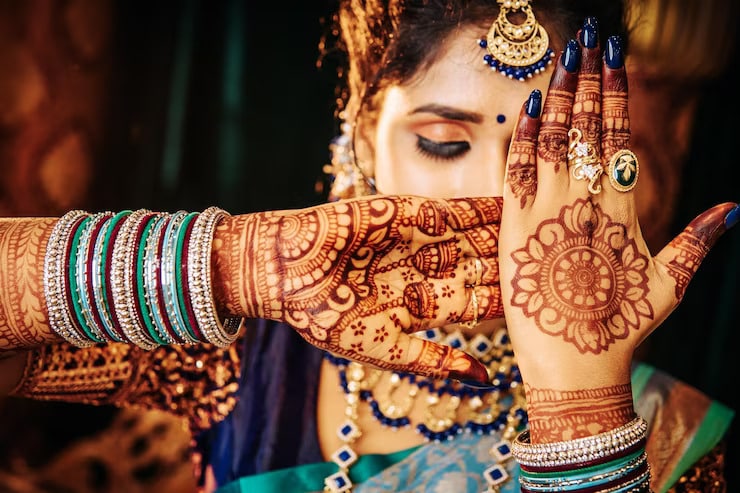
Informative
Navratri and Mehendi: A Spiritual Bond
Maa Bhagwati has blessed this world with a precious gift – a lush tapestry of medicinal plants. Even science agrees that these green medicines, made from plants, are far better and safer than man-made ones. For ages, folks have been using plants for medicine and natural stuff. Plants help keep us healthy and make our lives better by being in medicines, spices, drinks, beauty stuff, and colors.
Nature, in its wisdom, has bestowed upon us an incredible array of healing wonders, and many believe that these green medicines are not only effective but also gentler on our bodies compared to their synthetic counterparts.
Among the stars of this natural pharmacy is the Mehendi or Henna plant, which holds a special place in the tapestry of medicinal flora. In this blog, we’ll unravel the secrets and benefits of the Mehendi plant, exploring its historical significance, its role in traditional practices, and its diverse applications in the world of health and wellness. Join us on this journey through the lush realms of nature’s medicine cabinet!
Mehendi and Ancient cultures
In the ancient chapters of our history, the story of Mehendi unfolds with the Sanskrit word “Mendhika,” which points to the henna plant. A mummy from around 1,000 BCE was unearthed in Thebes, Deir el-Bahri – an ancient Egyptian temple complex and archaeological site. The female has reddish hair, which has been dyed with henna. This plant, with its ability to release a beautiful red dye, became the origin of the word “mehndi.” Mehendi’s journey goes way back, finding its earliest traces in the ancient civilizations of Babylon and Egypt.
As we trace the roots further, we discover that India embraced Mehendi early on, around the 4th century. The caves of Ajanta, adorned with ancient paintings, stand as proof of Mehendi’s prevalence in that era. It’s fascinating to think about how, even back then, people were using Mehendi not just for its red hue but also for its connection to art, culture, and perhaps even the pursuit of beauty and well-being.
Mehendi and Sanatana traditions
In the vibrant tapestry of Sanatana traditions, Mehendi has become a cherished art form, weaving its way into a myriad of festive celebrations. Hindu women, during auspicious occasions such as Karva Chauth, Vat Purnima, Diwali, Bhai Dooj, Navratri, Durga Puja, and Teej, adorn their hands and feet with intricate Mehendi designs. It’s not just a routine; it’s a beautiful expression of joy and cultural richness.
Expanding the canvas of traditions, Muslim women also embrace Mehendi during significant occasions like Eid al-Fitr and Eid al-Adha. The art of Mehendi transcends religious boundaries, becoming a shared celebration of beauty and cultural heritage. The evolution of Mehendi as an art form has truly become a colorful and inclusive celebration, bringing communities together in the spirit of joy and adornment.
Significance of Mehendi during the Navratri
Divine Feminine Embodied in Mehendi
During Navratri, the application of Mehendi becomes a sacred ritual embodying divine feminine energy. The intricate patterns drawn on hands and feet serve as a visual representation of the Goddess’s grace, empowering women to connect with their inner divine essence.
Empowerment Through Mehendi Artistry
The art of applying Mehendi during Navratri is not just about adornment; it’s a powerful expression of empowerment. Women, through the creation of elaborate designs, tap into their creative energy and assert their unique identity, fostering a sense of confidence and strength.
Nature’s Connection in Mehendi Rituals
Derived from the Mehendi plant, the natural essence of Mehendi fosters a deep connection with nature during Navratri. The act of applying Mehendi becomes a symbolic celebration of the earth’s energy, emphasizing the harmony between the natural world and the spiritual realm.
Symbolism and Body Chakras in Mehendi Designs
The intricate patterns of Mehendi hold spiritual significance, aligning with the concept of body chakras. Each design element corresponds to specific energy centers, enhancing the spiritual flow and balance within. Mehendi, thus, becomes a tool for channeling positive energy and promoting holistic well-being.
Inner Expression of Womanhood
Navratri Mehendi goes beyond surface-level beauty; it’s a profound inner expression of womanhood. The designs symbolize not only external adornment but also the internal journey of self-discovery and self-expression, allowing women to showcase their inner strength and beauty.
Mehendi as a Celebration of Sisterhood
The communal act of applying Mehendi during Navratri becomes a celebration of sisterhood. Women come together, sharing laughter and stories while adorning each other with Mehendi. This collective ritual strengthens bonds, creating a sense of unity and support among women.
Spiritual Symbols in Mehendi Art
The symbols used in Navratri Mehendi designs carry spiritual meanings. From auspicious motifs representing blessings to intricate patterns symbolizing protection, each element becomes a visual prayer, infusing the wearer with positive energy and divine grace.
Please subscribe to our mailing list to stay connected and receive spiritual information. In case of any queries, please write to us at info@chamundaswamiji.com. You can check out our YouTube channel Chamunda Swamiji where you can learn Tantra, Mantra, Yantra, and Meditation from His Holiness Shri Chamunda Swamiji. If you seek to learn Shakti Kriya, please register with us, and we will get back to you.
Post a Comment
-
Subscribe to Our Blog
-
Categories
-
Popular Articles
- Dead moth in the house. What universe is trying to tell you?
- Spiritual Meaning of Moth
- Vivah Bandhan Curse – What Is It and How to Spiritually Heal It.
- The Dasa Mahavidyas
- What are Beej Mantras?
- Tripura Sundari | The Dasa Mahavidya
- Maa Bhuvaneshwari | The Dasa Mahavidyas
- Ramakrishna Paramhansa – The Man who almost became a Woman
- The Five Shades of Tantra
- Maa Chinnamasta | The Dasa Mahavidyas



